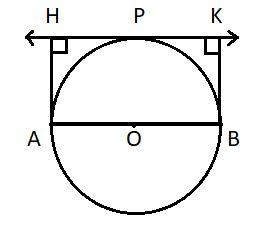
AB is a diameter of a circle. AH and BK are perpendiculars from A and B respectively to the tangent at P. Prove that AH+BK=AB
Answer
569.1k+ views
Hint: As per given data, we can draw a diagram that is

Now, AB is the diameter of the circle. O is the centre of the circle and AB passes through O. AH and BK are perpendiculars drawn from A and B on tangent P. P is the tangent of the circle. AH and BK are the perpendiculars drawn from the extremities of the diameter AB. As per the diagram ABKH is a rectangle because AH and BK are perpendiculars. So, from the diagram AB is equal to HK (opposite sides of the rectangle) and we also know that lengths of the tangents drawn from an external point to the circle are equal. And then adding the above equalities the proof for the above question will be found.
Complete step-by-step answer:
As per given data,
Perpendiculars drawn from A and B on tangent at P are AH and BK.
As AH and BK are perpendiculars
Therefore, ABKH is a rectangle
So, AB=HK (opposite sides of rectangle are equal) $...\left( 1 \right)$
We know that the length of the tangents drawn from an external point to a circle are equal.
So,
AH=HP $...\left( 2 \right)$
BK=PK $...\left( 3 \right)$
Now, adding Equation $\left( 2 \right)$ and $\left( 3 \right)$,
AH+BK=HP+PK=HK
From equation $\left( 1 \right)$
AH+BK=AB.
Hence, it is proved that when AH and BK are perpendiculars from A and B respectively to the tangent at P then AH+BK=AB.
Note: Perpendiculars always make ${90^ \circ }$ to the base and with that it is possible to say that ABKH is a rectangle. It is to be remembered that tangents from an external point to a circle are of equal length.

Now, AB is the diameter of the circle. O is the centre of the circle and AB passes through O. AH and BK are perpendiculars drawn from A and B on tangent P. P is the tangent of the circle. AH and BK are the perpendiculars drawn from the extremities of the diameter AB. As per the diagram ABKH is a rectangle because AH and BK are perpendiculars. So, from the diagram AB is equal to HK (opposite sides of the rectangle) and we also know that lengths of the tangents drawn from an external point to the circle are equal. And then adding the above equalities the proof for the above question will be found.
Complete step-by-step answer:
As per given data,
Perpendiculars drawn from A and B on tangent at P are AH and BK.
As AH and BK are perpendiculars
Therefore, ABKH is a rectangle
So, AB=HK (opposite sides of rectangle are equal) $...\left( 1 \right)$
We know that the length of the tangents drawn from an external point to a circle are equal.
So,
AH=HP $...\left( 2 \right)$
BK=PK $...\left( 3 \right)$
Now, adding Equation $\left( 2 \right)$ and $\left( 3 \right)$,
AH+BK=HP+PK=HK
From equation $\left( 1 \right)$
AH+BK=AB.
Hence, it is proved that when AH and BK are perpendiculars from A and B respectively to the tangent at P then AH+BK=AB.
Note: Perpendiculars always make ${90^ \circ }$ to the base and with that it is possible to say that ABKH is a rectangle. It is to be remembered that tangents from an external point to a circle are of equal length.
Recently Updated Pages
Two men on either side of the cliff 90m height observe class 10 maths CBSE

What happens to glucose which enters nephron along class 10 biology CBSE

Cutting of the Chinese melon means A The business and class 10 social science CBSE

Write a dialogue with at least ten utterances between class 10 english CBSE

Show an aquatic food chain using the following organisms class 10 biology CBSE

A circle is inscribed in an equilateral triangle and class 10 maths CBSE

Trending doubts
The shortest day of the year in India

Why is there a time difference of about 5 hours between class 10 social science CBSE

Write a letter to the principal requesting him to grant class 10 english CBSE

What is the median of the first 10 natural numbers class 10 maths CBSE

The Equation xxx + 2 is Satisfied when x is Equal to Class 10 Maths

What is the missing number in the sequence 259142027 class 10 maths CBSE




